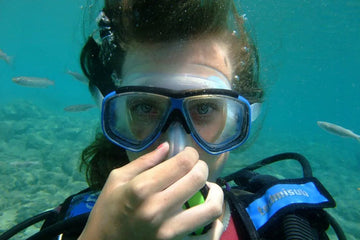By Por Jesús Núñez B3E, "Ex-sufferer-bad-equalizator "FEDAS 3E Group Guide, doctor and member of the sustainable diving section of the Center for Underwater Research and Activities of Madrid (CIAS).
These lines are meant to be an encouragement and a small tribute to all those "hard of hearing" divers whose ears usually do not allow them to descend at the same speed as the rest of their buddies, and who are even forced to interrupt a dive because of the pain caused by the unequlized water pressure, with a certain risk of tympanic rupture, dizziness, discouragement ... etc. So cheer up! and here is my experience.
Do not worry, I am not going to tell you about the anatomy and physiology of the ears. You have all had it explained to you in your courses and you can see it in many books and web pages, and it is of little use in our case.
Until recently, I belonged to the select and long-suffering group of "bad equalizing" divers. Ever since I took my first diving course 10 years ago, it has been a curse that has followed me on practically all my dives, becoming an obsession that, although it has not been able to destroy my passion for diving, has always made me feel anxious before each dive and has even managed to shorten many of them, due to excessive air consumption, until I reached minus 10 m, after which everything seemed to me to be a piece of cake.
T-shirts designed by divers for divers - Worldwide Shipping!
VIEW MORE T-SHIRTS FOR DIVERSThe thing started from minus 3 m and was invariably prolonged until the limit of my resistance to pain around minus 7 or 8 m, where because of that same pain I gave up and "flapped up" fortunately, since what common sense could not achieve due to the risk of breaking my eardrum, that lacerating pain did.
And so, again and again, in this short voyage, he performed 2,478 times (Guinness record) the maneuver of the blessed Valsalva, who, in addition to being old sure he was not a diver. He always managed to equalize the right ear, but the left one, as in life itself, was always protesting and on strike (no one should be offended because it was a "pathetic" license).
My descents during the dives were systematically produced by the anchor line and seeing most of my buddies going down like stones, who then had to wait patiently until the "yo-yo" diver managed to reach the minus 10m level, but with 40 or 50 atmospheres less in the tank. Seeing my buddies waiting below, going up and down for minutes, straining my ears, not letting go of the line, gave me a feeling of uneasiness, helplessness, guilt, which increased my stress, lowered my self-esteem, "screwed" my hearing, and emptied my tank. Only on some dives from shore, where we needed a long time to reach the depth, I was able to equalize almost effortlessly due to time and slowness.

I became so obsessed with the problem that I went to a good ENT specialist to discuss the problem with him, and after a complete examination in which he apparently discovered that I had an overdeveloped skull bone that narrowed my ear canal and squeezed the tubes, he concluded that I had to be PATIENT. Whether I liked it or not, I had to learn to live with it as one more of my many defects, in this case of manufacture, probably genetic in origin.
Since patience does not have to be synonymous with resignation, I dedicated myself to listening to every dive buddy about the different techniques to equalize, and I practiced them to the letter on every new dive I made.
So, at least a week before a trip to the sea, I dedicated myself to train my ears doing Valsalva maneuvers at all hours and all times ... in the car, at work, at home, reading, watching TV ... etc. but always trying to be alone, because the fact of pinching your nose and getting red faced in front of someone is anything but nice to say and can ruin from a great friendship to an intense moment of love.
Then, at the start, I would carefully wipe my nose before getting on the boat, and then, once in the water, I would do it all over again, sowing the seas with "nudibranchs" (but paying attention to where the current was going so as not to throw them to my friends).
Mugs for Ocean Lovers
SEE MORE MUGS FOR DIVERS
And after the usual apology to my companions for not equalizing properly, I went to the rope to begin my particular ordeal of "three steps forward and two steps back" using all the techniques and tricks I had heard, read and invented: I went completely vertical with my head up and my head down, with the regulator on and even removed at the moment of the equalizing maneuver, I opened and closed my mouth a thousand and one times, I turned my lazy ear up, I made the tubes vibrate by closing my mouth and saying "Ohmmm", which even though it did not clear my tubes, brought me closer to Nirvana? I always made my companions wait and despair, or on days with clear water I followed them overhead until I gradually reached their level or they reached mine. And I always returned home with my ears half plugged and with itching and discomfort in them for several days, plus an immense feeling of clumsiness that I tried to suffer in silence like an ugly hemorrhoid.
But my dears, in the end every effort is rewarded and he who follows gets it, so in the most unexpected way I found the solution, which as almost always was in a woman... I tell you:
Just before last summer and before a trip to the Azohía, I was lazily leaning out of a window of my house, performing the usual maneuver, when out of the corner of my left eye I saw a beautiful young woman pass by, which automatically made my head turn 90º, a wonderful moment because at that point of maximum rotation there was a "pluk" and my ear equalized while contemplating some beautiful curves.
I admit that at first I did not believe it, I thought it must be a strange coincidence, but no, every time I turned sideways to the limit, my neck produced the longed-for equalize, both to the left and to the right. What apparent nonsense, but what a sublime discovery for me!
At last I could fully enjoy the dives! And I have been enjoying them ever since, despite a certain amount of teasing that occurs when a diver notices me descending with a mysterious twitch in my neck.
I therefore solemnly ask for your support in changing the name of the VALSALVA maneuver to the HOTCHICK maneuver, while encouraging all "hard of hearing" divers to patiently try all kinds of maneuvers and especially grimaces, because even if they do not succeed in equalizing, they will make the wait for the other divers more entertaining.
My warmest greetings to all and my tribute to the "wooden eardrum" sufferers.

























